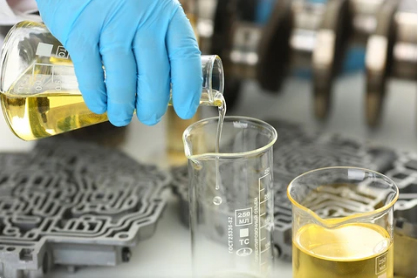Triflic Acid series products include a wide variety of compounds, though they are produced on a small scale and have high added value. Currently, the company manufactures Triflic Acid, Triflic Anhydride, TMSOTf, LiTFSI, Lithium Triflate, and other related products.

The production of Triflic Acid involves fluorination, electrolysis, hydrolysis, and acid digestion. Oxidation of Triflic Acid yields Triflic Anhydride, while its reaction with trimethylchlorosilane produces TMSOTf. When reacted with lithium carbonate, it forms Lithium Triflate. The intermediate compound Trifluoromethanesulfonyl fluoride (PFC-MSF, CAS 335-05-7) undergoes synthesis, acidolysis, and neutralization to produce LiTFSI.
As the strongest known organic acid, Triflic Acid offers a strong catalytic effect with minimal environmental pollution. Industries widely use Triflic Acid, Triflic Anhydride, TMSOTf, and other related compounds in pharmaceutical and chemical applications.
In the chemical industry, companies use Triflic Acid to replace traditional highly polluting strong acids such as sulfuric acid and perchloric acid.
In the pharmaceutical industry, manufacturers use Triflic Acid as a raw material or catalyst for drug intermediates, including nucleosides, antibiotics, steroids, glycosides, and vitamins.
Additionally, industries such as silicone, petrochemicals, rubber, flavors and fragrances, and pesticides rely on Triflic Acid for various applications.
LiTFSI and Lithium Triflate play a crucial role as components of lithium battery electrolytes. Battery manufacturers use these compounds as electrolyte additives to enhance electrochemical stability, increase energy density, and improve both high- and low-temperature performance as well as cycling efficiency. As key raw materials in green energy solutions, lithium battery additives are expected to see significant market expansion.
| Products | Uses | Applications | Production Capacity |
| LiTFSI | Lithium batteries (including solid-state batteries), electrolyte additives, ionic liquid raw materials, OLED material intermediates, etc. | Lithium-ion new energy, OLED materials, etc. | Mass production |
| Lithium Triflate | |||
| Triflic Acid | Reaction materials and catalysts for pharmaceutical or chemical intermediates | Pharmaceuticals, silicones, flavors and fragrances, chemicals, etc. | Mass production |
| Triflic Anhydride | |||
| TMSOTf |
Contact: Tony Li
Phone: +86-13263299644
Tel: +86-13263299644
Email: sales@ecoviaet.com
Add: No 3 Youyi Road,Tangshan,Huantai,Zibo,China
We chat
